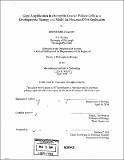| dc.contributor.advisor | Terry L. Orr-Weaver. | en_US |
| dc.contributor.author | Claycomb, Julie Michelle, 1977- | en_US |
| dc.contributor.other | Massachusetts Institute of Technology. Dept. of Biology. | en_US |
| dc.date.accessioned | 2006-02-02T18:49:23Z | |
| dc.date.available | 2006-02-02T18:49:23Z | |
| dc.date.copyright | 2004 | en_US |
| dc.date.issued | 2004 | en_US |
| dc.identifier.uri | http://hdl.handle.net/1721.1/31112 | |
| dc.description | Thesis (Ph. D.)--Massachusetts Institute of Technology, Dept. of Biology, 2004. | en_US |
| dc.description | Includes bibliographical references. | en_US |
| dc.description.abstract | The process of gene amplification in Drosophila ovaries provides a means of increasing the amount of template for transcription, thus increasing the amount of protein that can be made over a short developmental period. At a specific developmental point (egg chamber stage l0B-13), several clusters of genes encoding the eggshell (chorion) proteins in the follicle cells of each egg chamber are overreplicated 20 or 60 fold (for the X chromosome and third chromosome amplicons, respectively). Gene amplification is accomplished using the normal eukaryotic DNA replication machinery and a bidirectional DNA replication mechanism, and as such, is a powerful system for the study of metazoan DNA replication. Furthermore, the nature of the ovaries, with egg chambers of various ages arrayed in the order they were created, coupled with the use of cell biology, allows for the visualization of gene amplification at multiple timepoints in a single sample. We employed confocal and deconvolution microscopy to visualize the replication proteins ORC2, DUP/Cdtl, PCNA, and MCM2-7, as well as the nucleotide analog BrdU, at sites of gene amplification. These studies revealed that the BrdU staining pattern resolves from a focus of incorporation at the third chromosome locus in egg chamber stage lOB, to a coffee-bean structure in stage 11 egg chambers, to a double-bar structure in egg chamber stages 12 and 13. When coupled with quantitative real-time PCR calculations of copy number at the third chorion cluster during egg chamber stages lOB-13, these studies demonstrated that amplicon origin firing ends by stage 11 and that only the existing replication forks move out during stages 12 and 13 to produce the double bar BrdU pattern. | en_US |
| dc.description.abstract | (cont.) The localization patterns of replication initiation and elongation factors also support this model. The initiation protein, ORC2 is only found in foci during stages 1OA to 11, while the elongation factors PCNA and MCM2-7 resolved from foci at origins in stage lOB into the double bar staining structure representing replication forks in stages 12 and 13, similar to BrdU. We also observed that the replication initiation factor DUP/Cdtl colocalized with BrdU throughout amplification, and resolved into double bars, suggesting that DUP/Cdtl travels with replication forks during elongation. We hypothesize that DUP/Cdtl may be necessary for the nuclear trafficking and/or the adherence of the MCM2-7 to replicating DNA. In sum, this work has increased our understanding of the process of gene amplification and has provided a powerful tool for the study of replication fork progression and the proteins involved, an aspect of replication that has proven difficult to examine in vivo in other systems. Related BrdU studies revealed that there were two uncharacterized amplified regions in the follicle cells, thus we devised a comparative genomic hybridization microarray approach to systematically identify amplified portions of the genome. This approach identified the two uncharacterized amplicons, at cytological positions 62D5 and 30B 10. Using FISH/BrdU co-labeling and real-time PCR, we verified that these regions were amplified over a 75-100kb region. The new amplicon DAFC-62D was shown to have a final origin firing in stage 13, a time when the other amplicons are only elongating ... | en_US |
| dc.description.statementofresponsibility | by Julie Michelle Claycomb. | en_US |
| dc.format.extent | 203 leaves | en_US |
| dc.format.extent | 12725814 bytes | |
| dc.format.extent | 12751934 bytes | |
| dc.format.mimetype | application/pdf | |
| dc.format.mimetype | application/pdf | |
| dc.language.iso | eng | en_US |
| dc.publisher | Massachusetts Institute of Technology | en_US |
| dc.rights | M.I.T. theses are protected by copyright. They may be viewed from this source for any purpose, but reproduction or distribution in any format is prohibited without written permission. See provided URL for inquiries about permission. | en_US |
| dc.rights.uri | http://dspace.mit.edu/handle/1721.1/7582 | |
| dc.subject | Biology. | en_US |
| dc.title | Gene amplification in Drosophila ovarian follicle cells as a developmental strategy and model for metazoan DNA replication | en_US |
| dc.type | Thesis | en_US |
| dc.description.degree | Ph.D. | en_US |
| dc.contributor.department | Massachusetts Institute of Technology. Department of Biology | |
| dc.identifier.oclc | 56024418 | en_US |
